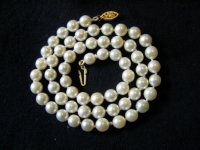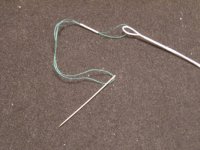flycatcher
Community member
- Joined
- Apr 25, 2008
- Messages
- 39
Greetings,
I am new to this site but I have been doing a bunch of reading in the Forums and have learned quite a bit. Thanks for all of the helpful information y'all have posted. I thought that I would post a picture of my first pearl restringing project. I see the flaws but I was pretty pleased with how it turned out. This is an 18" strand of pearls that I bought for my wife many years ago and I did not know as much about pearls as I do now (which still is not much) so they are not very high quality. They broke a few years ago and they have been sitting around waiting to be restrung. Her birthday rolled around and I decided having them strung would be a great present. Originally, I was planning to have this done by a trained professional but decided that I would give it a try myself first. Since it turned out "good enough" I am going to leave it as is. When I string them next I hope to be able to do a better job.
BTW, I learned the hard way to make sure that you start out with enough thread. Four pearls to go and I had to start over. I decided that thread was cheaper than time so I used an too long piece and had plenty left over. I will do that again next time. Also, after I was done, I figured out a better way to put the gimp on for the start of the clasp. Medium size gimp over a beading needle and two strands of size E thread doubled was a recipe for disaster. I wasted a lot of gimp before I got it right.
Anyway, y'all tell me what you think and what I could have done better. Thanks!
--Stephen
I am new to this site but I have been doing a bunch of reading in the Forums and have learned quite a bit. Thanks for all of the helpful information y'all have posted. I thought that I would post a picture of my first pearl restringing project. I see the flaws but I was pretty pleased with how it turned out. This is an 18" strand of pearls that I bought for my wife many years ago and I did not know as much about pearls as I do now (which still is not much) so they are not very high quality. They broke a few years ago and they have been sitting around waiting to be restrung. Her birthday rolled around and I decided having them strung would be a great present. Originally, I was planning to have this done by a trained professional but decided that I would give it a try myself first. Since it turned out "good enough" I am going to leave it as is. When I string them next I hope to be able to do a better job.
BTW, I learned the hard way to make sure that you start out with enough thread. Four pearls to go and I had to start over. I decided that thread was cheaper than time so I used an too long piece and had plenty left over. I will do that again next time. Also, after I was done, I figured out a better way to put the gimp on for the start of the clasp. Medium size gimp over a beading needle and two strands of size E thread doubled was a recipe for disaster. I wasted a lot of gimp before I got it right.
Anyway, y'all tell me what you think and what I could have done better. Thanks!
--Stephen




